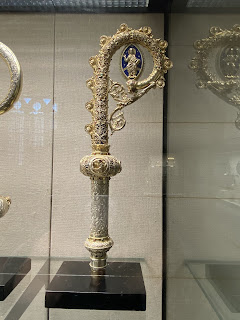Ok Domschatz, dritter Versuch, und ja, manchmal sind aller guten Dinge drei. Ich entrichte 1,50€ und mache mich auf, die Hallen mit dem Domschatz zu erkunden, schließlich ist es eine der ältesten und bedeutendsten Sammlungen in Deutschland und dann stehe ich in einem Raum von ca 40 m² und erster Gedanke ist: ist das alles? Ja, das ist alles. Der Domschatz umfasst eine Sammlung von Devotionalien und Reliquiengefäßen von der Spätantike bis zur Gegenwart, und ist durch alle Jahrhunderte und trotz aller Widrigkeiten erhalten worden bis zum 1. Koalitionskrieg im späten 18.Jahrhundert, da wurde viel Gold, also, sehr viel Gold an die kurfürstliche Münze abgegeben, um den Krieg zu finanzieren. Allerdings haben diese 500 Kilogramm Gold keinen Unterschied gemacht, Napoleon kam trotzdem.
Der Schatz wäre also viel umfangreicher, aber die wenigen verbliebenen Stücke sind sehr exquisit. Das älteste Stück ist ein Relief mit der Darstellung einer Prozession aus dem 5. Jahrhundert aus Byzanz. Auch sehr eindrucksvoll ein Bucheinband um ca 1170 und der Egbert-Schrein, ein tragbarer Altar Ende des 10. Jahrhunderts entstanden. Es gibt noch einige andere tragbare Altare aus der Spätromanik, kostbare Buchdeckel mit Edelsteinen eingelegt, Monstranzen und die Krümmen von Bischofsstäben, barocke Reliquiengefäße und Weihrauchfässer. Eine sehr beeindruckende Sammlung und definitiv einen Besuch wert.
In der Kirche, in religiösen Stätten generell wird viel über die Unsterblichkeit gepredigt und es gibt Maßnahmenkataloge, wie diese zu erreichen ist. Da ich nie Gottesdienste besuchen, weiß ich nicht, ob und wie oft darauf hingewiesen wird, dass dieses Handwerker, Künstler, die diese Schätze erschaffen haben, ihr Wissen und Können, vielleicht ihr Herzblut und einen Teil ihrer Seele in diese Werke gegeben haben, wahrhaftig unsterblich geworden sind. Ein Kleinod, dass vor 1500 Jahren erschaffen wurde, ist immer noch hier und kann von uns bestaunt werden, das für mich wahre Unvergänglichkeit.
English version below
Cathedral treasure, third try, but sometimes the third time is the charm. I pay 1,50€ (1,75$) and prepare myself to explore the halls with the treasure, one of the oldest and most important in Germany and I’m ending up in a room of 40 sq m and am like: huh, that’s all? Yep, that’s all. The cathedral treasure contains a collection of devotional objects and reliquaries starting from the end of antique time until today, and was kept safe throughout all odds during the centuries until the first French revolutionary war in 1792, then they donated a lot of gold, I mean, really a lot to the electoral mint to finance the war. In the end those 500 kilograms of gold didn’t made a difference, Napoleon came along anyway.
The collection would be way more larger, but those exhibits here are very exquisite. The oldest item is a relief of a religious processions in Byzanz from the 5th century. Very impressive also a book cover from 1170 and the Egbert-Shrine, a portable altar from the 10th century. There are other portable altars from late Romanic area, precious book covers with many gemstones, monstrances and the crooks of bishop’s staffs, baroque reliquary vessels and censers. It’s a very impressive collection and definitely worth a visit.
In the churches, in religious places at all is often spoken about immortality and there are big catalogs with measures how to become. Since I never attend a service I don’t know if or how often is spoken about the craftsmen, artists who created those treasures, that they put all their knowledge and skills, their heart and soul in them and reached real imperishability. That we still can see and be amazed by a gem that was made 1500 years ago, that’s true immortality.























Keine Kommentare:
Kommentar veröffentlichen